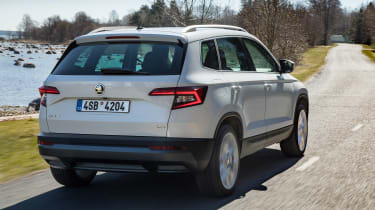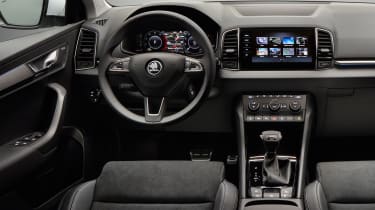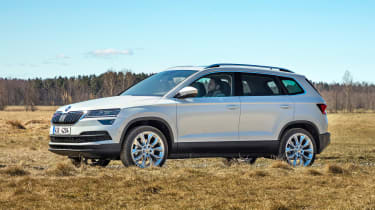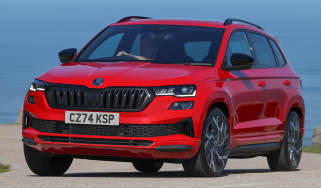New Skoda Karoq SUV: full UK pricing and specs revealed
Skoda's replacement for the Yeti will start from £20,875 when it goes on sale on 3 October
Skoda has announced details of UK pricing and specfication for its new Karoq SUV. The replacement for the Yeti will be available to order from 3 October priced from £20,875.
That starting price nets you a Karoq with a 113bhp 1.0-litre TSI turbo petrol engine in SE spec, with standard kit including 17-inch alloys, dual-zone climate control, front assist and LED rear lights.
You'll need to upgrade to SE L spec (from £23,165 with the same engine) to gain items such as an eight-inch touchscreen sat-nav, keyless entry, LED headlights and Alcantara upholstery. Flagship edition models (from £27,110 with a 148bhp 1.5-litre TSI petrol) include 19-inch alloys, a panoramic sunroof, leather, a more advanced touchscreen and an electric bootlid.
Two petrol and two diesel engines will be available at launch. The 1.0-litre and 1.5-litre TSI petrols come with a six-speed manual transmission, but can also be specced with a seven-speed DSG gearbox. 113bhp 1.6-litre and 148bhp 2.0-litre diesels can also be had with the DSG 'box, while the latter comes with the option of four-wheel drive.
The Karoq is a notably larger vehicle than the one it replaces. It’s 4,382mm long and 1,841mm wide - figures that are 160mm and almost 50mm up on the Yeti’s dimensions respectively. The Karoq’s wheelbase is 60mm longer too, at 2,638mm if you choose a front-wheel-drive edition (2,630mm for four-wheel-drive models).
The new Skoda’s wheelbase figures are identical to those of front- and four-wheel-drive versions of the SEAT Ateca - but that’s no surprise, given that both cars are produced on the VW Group’s MQB chassis architecture. Indeed, there are plenty of family traits visible in the Karoq’s side profile, because it’s strong, sharp shoulder line looks very similar to the Ateca’s. A Skoda family grille and more complex tail-lights do help to separate the VW Group stablemates at the front and rear, but the overall look is more restrained than the funky Yeti’s.
We already know that the Skoda Karoq range will expand rapidly over the next 12 months with SportLine and Scout versions arriving. Skoda bosses also admit that a plug-in hybrid is on the cards, while a high-performance Skoda Karoq vRS edition is under consideration. The Czech company’s CEO Bernhard Maier told Auto Express that the firm has already detected customer demand for a faster version of the new SUV - one that could carry the vRS badging that’s currently limited to the Octavia.
Skoda Kodiaq 2017 Frankfurt Motor Show Livestream
Skoda Karoq engine range
The Karoq is being launched with a line-up of five engines. There are two petrols - a 1.0-litre three-cylinder unit with 113bhp and 175Nm that emits 117g/km of CO2, and a 1.5 four-cylinder producing 148bhp and 250Nm; thanks in part to cylinder deactivation technology, this more potent engine almost matches the triple’s CO2 emissions, at 119g/km.
• Best crossovers on sale right now
The entry-level diesel is a 1.6-litre motor, producing 113bhp and 250Nm of torque, and emitting 118g/km of CO2. Then there’s a 2.0 with 148bhp and 340Nm - enough for a 0-62mph time of 8.9 seconds, despite the lowest CO2 emissions of the entire Karoq range, at 115g/km.
The range-topping motor is a 2.0-litre diesel with 228bhp and 400Nm. It’s offered only with four-wheel drive and a seven-speed dual-clutch automatic transmission (all of the other motors get a six-speed manual and front-drive as standard). Skoda claims it can crack 0-62mph in 7.8 seconds and reach a top speed of 131mph - although its CO2 emissions of 138g/km mean it’s likely to be one of the niche choices in the range, especially in the UK.
Front-drive Karoqs will have a choice of driving modes, and Dynamic Chassis Control (available on the 1.5- and 2.0-litre variants) offers adjustable electro-hydraulic suspension. Four-wheel-drive editions can be specified with an off-road mode, which uses the traction control system and an electronic differential lock to improve traction. The options list will also include a Rough-road package that adds more underbody protection if you know you’re going to be taking your car onto tougher terrain.
• New Skoda Karoq prototype review
Skoda Karoq cabin and tech
Inside, the Karoq showcases the latest version of Skoda’s interior design, with four vertical air vents punctuating the fascia, and the central infotainment screen mounted high up and in the centre of the dash. The car is a five-seater, and its longer wheelbase delivers considerably more passenger space than in a Yeti, especially for rear-seat occupants.
The boot capacity grows too, up to 521 litres if the rear seats are fixed, and 1,630 litres if they’re folded down. But Skoda is offering an optional system called VarioFlex, which allows you to move all three of the rear seats individually - or to remove them altogether. Capacities with this configuration range from 421 litres if you priorities legroom for all three rear passengers and 588 litres if you elect to maximise boot space, to 1,810 litres with the second row removed entirely.
There are four infotainment options. The entry-level Swing has a 6.5-inch touchscreen and includes DAB radio and Bluetooth connectivity. The next system up, Bolero, gets a higher-resolution eight-inch screen, and includes SmartLink+ for Android Auto and Apple CarPlay compatibility - although this feature is available as a standalone add-on for Swing.
Amundsen uses the same screen but includes navigation and a wi-fi hotspot, while the range-topper, called Columbus, is based on a 9.2-inch display and includes a DVD/CD drive and 64Gb of onboard memory. It also has the option of an LTE module that brings faster internet for the hotspot, and introduces gesture control to a Skoda for the first time.
The Karoq is also the first Skoda to get the VW Group’s digital instrument panel, as seen on the Audi TT and the latest VW Golf. It offers a range of layouts designed to prioritise driving data or a range of additional information, including navigation instructions, a gear indicator or traffic sign information.
Other features (optional on some versions) include LED ambient lighting that can offers a choice of 10 colours, puddle lights that illuminate the area around the door during entry and exit, full-LED headlights and foglights, and an electric tailgate that can be operated by waving your foot below the rear bumper.
The line-up of safety kit includes blind spot detection, rear-traffic alert, lane-keep assist and traffic sign recognition - although some of these feature on the options list, along with the different designs of 17in, 18in and 19in wheels to choose instead of the standard 16in and 17in items.
The Karoq is due on sale in the final quarter of this year, with first deliveries expected in January 2018. We’d expect it to cost more than the Yeti, with a starting price of around £17,500.
What do you think of the new Skoda Karoq SUV? Let us know in the comments section below...
Find a car with the experts











